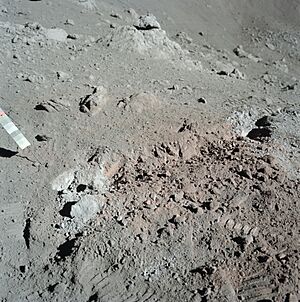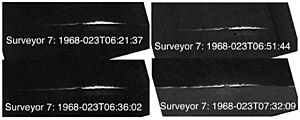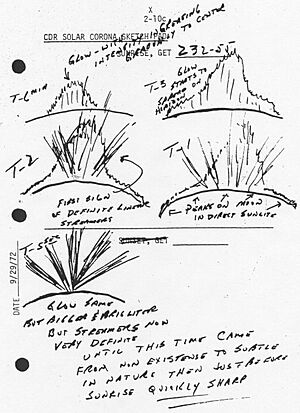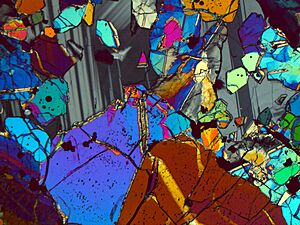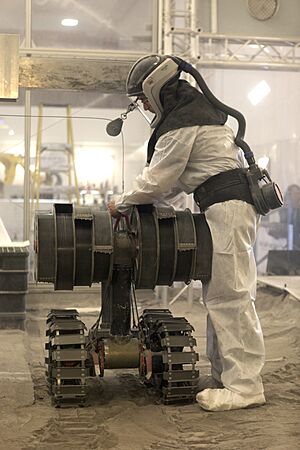Lunar regolith facts for kids
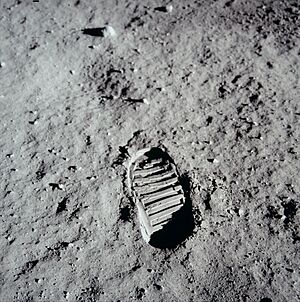
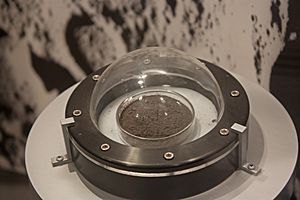
Imagine the Moon's surface. It's not smooth rock! It's covered in a layer of loose, dusty material called lunar regolith. Think of it like the Moon's very own "soil." This lunar regolith is found all over the Moon's surface. It even floats around in the Moon's super-thin atmosphere.
When we talk about "lunar soil," we usually mean the tiny bits of regolith that are smaller than 1 centimeter. This Moon dust is very different from the soil we have here on Earth. It's made of sharp, sticky particles. Astronauts have even said it smells and tastes a bit like gunpowder!
This special Moon dust is important for future space missions. Scientists are looking into using it to build things on the Moon. They are also exploring if it can help grow plants there.
Contents
What is Moon Dust?
Lunar regolith is the loose material covering the Moon. It's like a blanket of dust and tiny rocks. This material is not stuck together. It's very fine, like powder. Because it's so light, even small forces can move it around. This means it can easily get on equipment and be a challenge for astronauts.
The term lunar soil refers to the smaller parts of lunar regolith. These are grains that are 1 centimeter or less in size. Lunar dust means even finer materials. There isn't one exact size for "dust." Some say it's particles smaller than 50 micrometers. Others say it's smaller than 10 micrometers. A micrometer is super tiny, much smaller than a human hair!
How Moon Dust Forms
Moon dust forms over billions of years. It's mainly created by space rocks hitting the Moon. These impacts are like tiny hammers. They constantly smash the Moon's rocks into smaller and smaller pieces. This process is called comminution.
Another way dust forms is through agglutination. When tiny meteorites hit the Moon, they create a lot of heat. This heat melts some of the rock and mineral pieces. These melted bits then stick other fragments together. This forms new, irregular particles.
The Solar wind also plays a role. It's a stream of tiny particles from the Sun. These particles hit the Moon's surface. They can knock off even smaller bits of dust. This is called sputtering. All these processes together change the Moon's surface over time. This is known as space weathering.
Sometimes, volcanoes on the Moon also made dust. Hot lava would shoot up and cool quickly. This formed tiny glass beads. These beads then fell back to the surface. For example, astronauts found orange dust at a place called Shorty Crater. This dust was made of these volcanic glass beads.
Dust Moving on the Moon
Scientists believe there's a thin layer of dust always moving on the Moon. It's like a "dust atmosphere." This dust isn't still; it's constantly jumping up and falling back down. Some call this the "Moon fountain." It looks calm, but the dust particles are always in motion.
Why Dust Floats
This movement happens because of electrostatic levitation. On the Moon's day side, sunlight hits the dust. The Sun's powerful ultraviolet and X-ray rays knock electrons off the dust particles. This makes the dust particles gain a positive electric charge. When they have enough charge, the tiniest dust particles (1 micrometer or smaller) push away from the surface. They can float up from a few meters to several kilometers high. Eventually, they fall back down, and the process starts again.
On the Moon's night side, dust gets a negative charge from the solar wind. This might make dust particles jump even higher. This effect could get stronger when the Moon passes through Earth's magnetotail. This is a part of Earth's magnetic field. At the line between day and night (the terminator), strong electric fields can form. These fields can cause dust to move sideways. This creates a kind of "Moon storm."
Astronauts have seen signs of this dust movement. In the 1960s, the Surveyor spacecraft took photos. These photos showed a faint glow low over the Moon's horizon after sunset. The distant horizon also didn't look perfectly sharp. This was unexpected for a place with no air. In 1972, Apollo 17 astronauts saw "twilight rays" before sunrise or sunset. These might be like the rays of light we see on Earth.
An experiment called LEAM (Lunar Ejecta and Meteorites) was placed on the Moon by Apollo 17. It was designed to find dust kicked up by small meteoroids. LEAM detected many particles every morning. They mostly came from the east or west. They were also slower than expected for meteoroid impacts. The experiment also got very hot after sunrise. Scientists think this might have been charged Moon dust sticking to LEAM. This would make its surface darker, absorbing more sunlight.
People on Earth might have even seen these dust storms. For centuries, there have been reports of strange glowing lights on the Moon. These are called "transient lunar phenomena" or TLPs. Some TLPs are quick flashes from meteoroids hitting the Moon. But others are reddish or whitish glows. They can change shape or disappear quickly. These might be sunlight reflecting off floating Moon dust.
Dust Clouds from Human Activity
The Moon has a very thin atmosphere. But human activities there could create dust clouds. For example, spacecraft landing or moving around. These dust clouds could spread far across the Moon. They might even change the Moon's natural state. This could affect future scientific studies.
What Moon Dust is Like
The Moon's surface is covered with a thin layer of dust. This is because of countless meteorite impacts. These impacts happen at very high speeds. The dust particles are electrically charged. This makes them stick to almost any surface they touch.
Moon dust is not very dense at the surface. It's about 1.5 grams per cubic centimeter. But it gets denser the deeper you go. Other things affect Moon dust too. These include huge temperature changes. The Moon also has a hard vacuum (no air). And it doesn't have a strong magnetic field. This means charged particles from the solar wind constantly hit its surface.
What is Moon Dust Made Of?
The Moon dust's makeup depends on the rocks it came from. Over time, impacts mix the material. This happens both up and down, and side to side. This mixing is called "gardening." So, dust from different areas of the Moon has slightly different mixes. But the basic minerals are similar.
Common minerals in Moon dust include plagioclase and olivine. Glass is also very common. It forms when impacts melt the rocks. Ice can also be found in craters that are always in shadow. Moon dust is often described as tasting and smelling like used gunpowder.
Moon dust has different types of tiny pieces. These include small rock fragments and single mineral pieces. There are also various kinds of glass. Some glass pieces are called agglutinates. These form when micrometeorites melt tiny bits of material. This fuses them together. Each tiny dust particle can have tiny specks of iron inside its glassy outer layer.
Moon dust is different from Earth soil in two main ways. First, the Moon is extremely dry. So, minerals that need water to form, like clay, are not found there. Second, Moon dust is "reduced." This means it has less oxygen compared to Earth's soil. This is partly because protons from the solar wind constantly hit the Moon. For example, iron on the Moon is often found in a pure, elemental form. On Earth, iron is usually found combined with oxygen.
Why Moon Dust is a Challenge

Moon dust can cause problems for equipment and astronauts. In 2005, a NASA study looked at risks for a human mission to Mars. They listed "dust" as a top challenge. The concerns about Martian dust are also true for Moon dust.
How Dust Affects Astronauts
Moon dust can be very abrasive. This means it can scratch and wear down surfaces. It can damage things like spacesuits and equipment seals. It can also harm optical lenses, solar panels, and windows. Wires can also be affected.
More importantly, Moon dust can affect astronauts' health. If inhaled, it could irritate their lungs. It might also affect their breathing and overall well-being. There's also a risk of spacesuits having electrical problems. This can happen if small dust grains get exposed to the space environment.
Astronauts on the Apollo missions reported some discomfort. After walking on the Moon, their spacecraft would be full of dust. Many astronauts said they coughed. They also had irritated throats, watery eyes, and blurry vision. These issues usually went away within a day. Scientists are still studying the long-term effects of Moon dust exposure.
Protecting Against Dust
To protect astronauts and equipment, special steps are needed. These include ways to remove dust from spacesuits. Astronauts might use a three-stage airlock. They could also "vacuum" their suits with a magnet. Special filters can remove dust from the spacecraft's air.
Scientists are working on new ways to deal with Moon dust. They are testing special spacesuits. They are also looking into using dust shields. Magnets can help separate dust. Even using sunlight to melt the dust could be a solution.
Using Moon Dust
Scientists are exploring ways to use Moon dust. One idea is to use it for building structures on the Moon. This could be like making "lunar concrete." This would save a lot of money and effort. We wouldn't have to send building materials from Earth.
Growing plants in Moon dust is another big challenge. Moon dust is very different from Earth soil. Plants might struggle to grow in it. Future space missions will need food. So, scientists are trying to find ways to make Moon dust suitable for plants. This might involve treating the dust. Or, they might try to grow special types of plants that can handle the Moon's soil. In May 2022, scientists successfully grew a plant called Thale cress in lunar regolith. This was a big step!
Studying Moon Dust on Earth
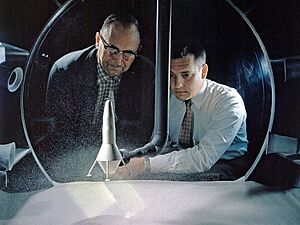
The Apollo astronauts brought back about 360 kilograms of Moon rocks. These samples have been studied a lot. However, they are now contaminated by Earth's air and moisture. This means their original properties have changed. The dust has rusted a bit. Its chemical and electrical properties are no longer exactly like they are on the Moon. This makes it harder to study how future astronauts will experience it.
In 2014, some Moon dust-related items became available to the public. These were items owned by astronauts. For example, a luggage strap from the Apollo 12 mission was sold. It had been exposed to the Moon's environment. In 2017, Moon dust collected by Neil Armstrong was also put up for auction. Many jewelry makers claim their products have "Moon dust." But usually, this is dust from meteorites that came from the Moon, not actual Moon dust collected by astronauts.
In 2020, NASA announced it wants to buy lunar regolith from companies. This is to create a market for Moon resources.
China's Moon Missions
On December 16, 2020, China's Chang'e 5 mission returned to Earth. It brought back about 2 kilograms of Moon rock and dust. This was the first time Moon samples were brought back since 1976. China is the third country to bring back such material.
The Chang'e 5 mission is part of China's plan to explore the Moon. Another mission, Chang'e 6, collected samples from the far side of the Moon in 2024. China plans more missions in the future. They also hope to land Chinese astronauts on the Moon between 2030 and 2039.
See also
- Lunar resources
- Lunar terrane
- Selenography
- Sodium tail of the Moon


